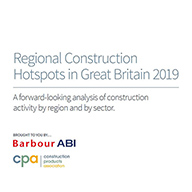At UK Construction Week 2017 Transport for London gave a talk detailing their plans for driving income and innovation through commercial and residential development.
Transport for London
TfL are one of London’s major land owners, owning 5,700 acres of land and property in London. TfL have planned to use their landholdings to deliver 10,000 homes across 300 acres in a bid to meet Mayor Sadiq Kahn’s affordable housing aspirations.
And indeed, in 2016/2017 TfL brought sites to market that will deliver almost 1,000 homes, half of which will be affordable.
Working with their framework of 13 leading developers, TfL hope that the programme will offer an opportunity to build homes and communities around transport hubs.
Though there is some debate as to how “affordable” TfL’s affordable homes will be, could this kind of development strategy the answer to the UKs housing problems?
Transport investments lead to development
In a document published by Campaign for Better Transport, they comment on the current norm for housing development.
Stating that since the Second World War domestic housing has been developed in a low-density sprawl, often popping up on the outskirts of towns and cities near major roads. The same with commercial developments such as retail and business parks.
This has led to a nationwide car dependency. Which is not only an ecological problem but can cause issues for the country’s population who do not have the means or access to road vehicles. Typically out-of-town properties are inhabited the financially comfortable.
The document argues that a more sustainable development approach can support the economy, aid community cohesion and offer affordability. The report calls for a new relationship to be forged between spatial planning and transport. Aiming to bring life back to the countries high streets, support local business growth and encourage inner city affordable residential development.
The Campaign for Better Transport argue for a focus on urban brownfield development based around sustainable transport links.
They use the example of the Kent FastTrack, a rapid bus transport service that hopes to create 30,000 more houses by 2030. They also feature Shawfair, Scotland’s first new town in 50 years, will be built around Shawfair train station which offers a journey time of just 10 minutes to Edinburgh. The town will have its own retail, business and leisure facilities and boast an additional 40,000 houses.
In 2016 Mark Carne, Chief Executive of Network Rail, called on businesses to invest rail projects and improvement stating that: ‘All over the country, we have seen the impact of rail improvements, new stations, new lines. When railways are introduced or upgraded, investment in housing inevitably follows as businesses choose to move or set up in or near those areas.”
This followed Network Rail’s release of land for the development of around 12,000 new homes.
Barking Riverside
Similarly we see the development of Barking Riverside, a brownfield development that is to include up to 10,800 new homes. This development is planned around the £263m extension to the existing Gospel Oak to Barking London Overground line. A target of 50% affordable housing has been set for the development.
The Mayor of London commenting that: ‘Barking Riverside has enormous potential to deliver thousands of the much-needed homes Londoners so urgently need.’
‘Our next task is to ensure this development includes the facilities and infrastructure which will make this a fantastic place to live and to visit, rather than simply a housing development.’
Rail overbuild in London
In October 2017, WSP released a report commissioned by Network Rail which examines the potential in the capital for rail overbuild at sites where there was 10m of available land on both sides of track.
WSP analysed all the rail tracks in Transport for London’s (TfL) fare zones 1-6 , and in their report, titled 'Out of Thin Air', claim that there is the potential to provide all the new homes London needs if apartment blocks were constructed directly above these lines.
This would amount to 100m² of apartments in buildings rising to 12 storeys. They estimated that If just 10% of this total was delivered, it would provide 250,969 new homes, with the boroughs of Brent, Ealing and Croydon having the most "overbuild" potential.
WSP director Bill Price said: “We have to be more creative in using existing space in what remains a relatively low-rise city. The air rights above rail tracks present an unrealised but significant opportunity to build more new homes on brownfield land.
"We have been working on projects of this nature in New York for decades. Right now in London we are working on a variety of projects that rise above rail lines including a 50-storey residential tower, homes above a new Crossrail station and even a Premier League stadium.”
The report emerged after Network Rail asked WSP to study the practicability of building above rail lines in 2012. The study’s conclusions, which focused on the type of decking and noise and vibration issues are detailed in the new report.
These images from WSP's report suggest what could be developed above the rail tracks leading to and from Victoria station.
Visit the Construction Enquirer for more information.
Crossrail and Crossrail 2 also promise to increase development and local investment around the new stations the routes produce. To find out more, and for a run down of the Crossrail project from start to finish read our post.
So, what are your thoughts? Do you think further investment into and development of transport infrastructure is the key to solving the UKs housing crisis?
Click to find out more about Transport for London's development plans.
Join our discussion on LinkedIn.
Related Blog Articles


crop192.png)













